In the Fact Tracker series by Mary Pope Osborne and Natalie Pope Boyce, there’s a non-fiction companion book for each of the books in the original Magic Tree House series by Mary Pope Osborne – a series that has been delighting young readers (and their parents and teachers) for years. The Magic Tree House books introduced readers to historical events, animal stories, mythological tales, and scientific topics in an accessible, informative style. In the non-fiction companion Fact Tracker books, readers will discover more detailed information about the subjects they came across, from dinosaurs and pirates and dolphins, to Washington Crossing the Delaware, the eruption of Pompeii, the first Thanksgiving and the walk on the moon. Combining photographs, illustration, the phonetic spelling of difficult words and short, fun and pithy facts delivered by Jack and Annie in the wide margins, the Fact Tracker books are a treasure trove of material for curious readers. The detailed information is easy-to-read, interesting and exciting. Readers will learn more than they even realize by reading these books, and come to understand that doing research is actually fun!
Princess Posey, First Grader
Since Princess Posey’s debut in PRINCESS POSEY and the FIRST GRADE PARADE, I’ve been in love with this series. I’ve happily read the books aloud and shared them with many classes of students who feel as I do. Posey, with her sweet, but fiercely honest and earnest nature, feels like one of us. Her problems at school and home are heartfelt and true. She loves her family, but struggles with the same sorts of questions as other children her age.
In PRINCESS POSEY AND THE FIRST GRADE BALLET – the ninth (and newest book) in the series – Posey must deal with the very real problem of money – wanting things she can’t have, comparing herself to others, and understanding that true riches are not measured in the things we own, but the people we know and the experiences we’ve been given.
Posey loves her ballet class more than anything. She’s looking forward to wearing a beautiful heart costume for her first recital – a Valentine ballet. But Posey’s mom says she can’t afford to buy a new leotard and Posey has to wonder. Is her family poor? She doesn’t dare ask.
When she finally musters the courage to learn the answer to her hardest question, Posey’s understanding of the world grows a tiny bit wider, and her heart with it. Even so, will Princess Posey find a way to help Jade, the new child in her class who truly is less fortunate than her? She does, of course, and it’s a sweet moment.
And perhaps that’s another reason I love Posey. She tackles difficult problems and, as readers, we get to watch her grow in important, realistic ways.
Learn more HERE about Stephanie Greene, author of the Princess Posey series and HERE about the series’ illustrator, Stephanie Roth Sisson.
Sheep Go to Sleep by Nancy Shaw
Oh, happy day! Author Nancy Shaw and illustrator Margot Apple have collaborated once again to create another splendid book in their highly acclaimed Sheep in a Jeep series – Sheep Go to Sleep (Houghton Mifflin Harcourt, 2015).
Sheep Go to Sleep is a charming story about a dutiful sheepdog’s struggle to herd those silly sheep to bed, and what a restless and demanding bunch they are! Before they can rest, they need drinks of water and special blankets and on and on… Then, when the precious collie is at the point of exhaustion, the moment comes when those sheep finally surrender and snuggle down to sleep.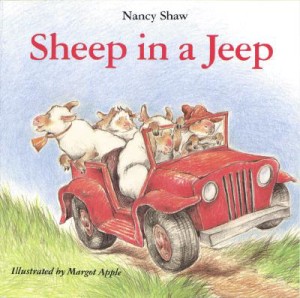
As are all of the books in the Sheep in a Jeep series, Sheep Go the Sleep is perfectly crafted for the young child in the most whimsical, comical, and heart-warming way. Don’t wait until May 5th when this newest book in the series arrives on bookstore shelves – preorder the book now! And while you’ll at it, pick up a copy of the Sheep that started it all – Sheep in a Jeep.
THE BLISS OF BOOK SERIES
Looking for a good book? No matter if you are big or small, there’s nothing better than finding the next book in a favorite series written by a favorite author. For readers in the early-elementary grades, one of the most popular – and delightful – series is the BABY MOUSE books written by Jennifer L. Holm and illustrated graphic-style by Jennifer’s brother, Matt.
Try the newest award-winning, book number #18 in this series: HAPPY BIRTHDAY BABY MOUSE.(Random House Books for Young Readers, 2014)
Already this book has been chosen by young readers as a 2015 Children’s Choice Book award finalist.
The author, Jennifer L. Holm, is a three-time Newbery-honor award winner and for good reason, her books are wonderful. Jennifer and Matt are also the creators of the SQUISH series. My very favorite is one of Jennifer’s first books, the historical novel for the middle-grade reader, OUR ONLY MAY AMELIA. Set in Washington in 1899 the reader follows the delightful story-telling of May Amelia Jackson, a pioneer girl with seven older brothers and a love for adventure and mis-adventures!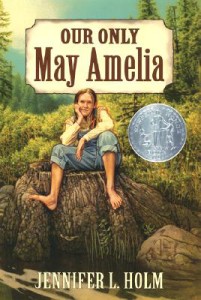
For more best-books, take a look at the whole list of this year’s Children’s Choice Book Awards Finalists. Yes, you will find HAPPY BIRTHDAY BABY MOUSE and five books in each age category. These books have been chosen as “best” by the thousands of children who have read them. For more information and the full list of books, read more here:
Press Release: Eighth Annual Children’s Choice Book Awards Finalists Announced:
http://mrschureads.blogspot.com/2015/02/press-release-eighth-annual-childrens.html?m=1
Looking for a series for the very young listeners? A new series just out are the PUMPKINHEADS board books, colorfully illustrated and simply written, but each tell an engaging story.
Each book has a simple value embedded within the story. A variety of child characters are each working through typical preschool child problems and concerns, for example:
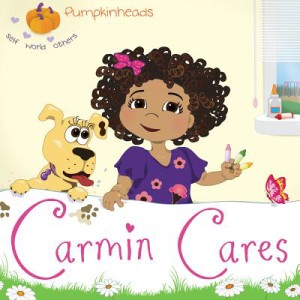 CARMIN CARES, (no littering, keep the playground clean), ELLA’S TOYS (and Ella does NOT want to share), LOVE MONSTER LULU who likes to tease the dog, chase the cat and make life rather annoying for everyone, and SAGE’S SONG – fun to sing along, listen to the music all around you.
CARMIN CARES, (no littering, keep the playground clean), ELLA’S TOYS (and Ella does NOT want to share), LOVE MONSTER LULU who likes to tease the dog, chase the cat and make life rather annoying for everyone, and SAGE’S SONG – fun to sing along, listen to the music all around you.
Each book is printed on kid-tough paper from sustainable forests. The books were created, written, and designed by Karen Kilpatrick and illustrated by a variety of Pumpkinhead storyboard artists, Matthew Wilson and Tara Campbell leading the way. The Pumpkinhead website link is http://www.pumpkinheads.com/
Oh, no, not again!
Jack’s scatterbrained parents did it – again. Hilarious action and dangerous rapids rule the day in Jack at the Helm (Darby Creek Publishing) by Lisa Doan, the third and final book in the Berenson Schemes Series.
The Berenson’s high hopes to make their fortune while not losing Jack – once again – to fend for himself in a foreign territory, fail. Plans are for Jack’s parents to become co-Dalai Lamas of Nosnereb, their newly created religion (Nosnereb is Berenson spelled backward) and to purchase a monastery in Shangrilala, Nepal. However, after a series of unfortunate events, Jack is stranded and forced to survive the treachery of the rugged Himalayan River. But this time, things are different.
Reluctant readers are sure to be with Jack every step of the way as he climbs onto a beaten-up old raft and goes down-river to battle crocodiles, rocks, and rapids in search of his missing parents.
Dooby Dooby Moo…Shh!
DOOBY DOOBY MOO by Doreen Cronin and Betsy Lewin (Atheneum Books for Young Readers, 2006)
When farm animals make their way into a picture book, you can usually be certain that good fun’s ahead. When those animals happen to be the notorious Duck, Sheep, and Cows from Cronin and Lewin’s CLICK, CLACK, MOO: Cows That Type, you can be assured of plenty of giggle-worthy shenanigans. This time, Duck has his eye on winning 1st prize at the county fair talent show – a (slightly used) trampoline. With deadpan humor and Lewin’s comical illustrations, DOOBY DOOBY MOO is another winner by this talented author/illustrator duo.
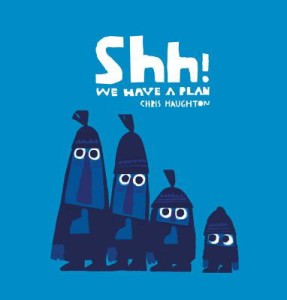
Shh! We Have a Plan by Chris Haughton (Candlewick Press, 2014)
Four figures make their way through a nighttime forest until…”Look! a bird.” When the smallest one calls out, “hello, birdie” the other three are quick to reprimand – “shh…SHH!…we have a plan.” Quietly the three approach the brightly colored bird. “ready one… ready two… ready three…GO!” While the three land in a big tumbly mess, the bird easily escapes. And so it goes as the foursome follow the bird up a tree and over a river, each time with similar results. But the littlest one really does know what he’s doing. Offering a handful of bread, it isn’t long before he’s surrounded by not one, but dozens of birds. The three pull out their nets for one last “ready one… ready two… ready th… RUN AWAY!” Off they go again, angry birds on their heels. Until… “Look! a squirrel…SHH! we have a plan.” Bold, colorful illustrations add to the visual humor and make this a book kids and adults will enjoy reading over and over again.
TERRIBLE TOADS? GOOD NIGHT LOON! TO MARKET … Really?
A new, wonderfully silly, hot-off the award lists picture book is KID SHERIFF AND THE TERRIBLE TOADS, written by Bob Shea and Lane Smith. Toad problems in Drywater Gulch! Serious toad problems: “thievin’, lootin’, and hollerin/, steal-your-gold never-say –thank you outlaw toad problem.” Hope for Dry Gulch arrives in the boots of Sheriff Ryan, a bit young you might think, seven years old, but he knows dinosaurs. Yes, dinosaurs and paleontology. Knowing paleontology turns out to be exactly what is needed. You got to read it to believe it.
GOOD NIGHT LOON is a just plain silly, tummy-laughing-till-hurting delight.
We all can close our eyes and see the soothing, green pages of GOOD NIGHT MOON.
GOODNIGHT LOON by Abe Sauer and illustrated by Nathaniel Davauer is a north woods silly-giggly version with a Big Blue OX jumping over the loon watched by three fat walleyes eating rhubarb pies. Don’t worry, there’s Tater Tots for those not excited about rhubarb. GOOD NIGHT LOON is fun for the big folks and ancient voyageurs who enjoy reading between loony lines.
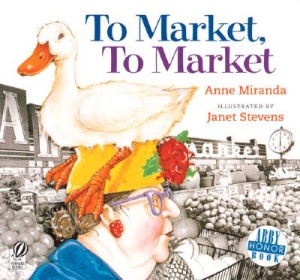 Now we know what the North Folks do during those long, dark snow-covered winters.
Now we know what the North Folks do during those long, dark snow-covered winters.
And one more for giggles and laughs. My very favorite picture book that makes me laugh out loud even after a zillion readings is – TO MARKET, TO MARKET written by Anne Miranda and illustrated by infamously-delightful, Janet Stevens. Two terrific imaginations have created page after page of hilarious words and images. “To market, to market to buy a live TROUT. Home again …Uh-oh! The goose was let out.” The pigs in the frig, the hen’s in the oven…and where’s that lamb now?
Try it, you’ll love it!










